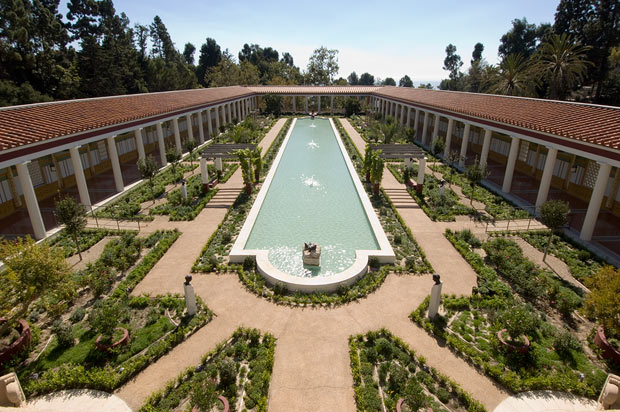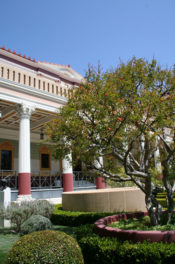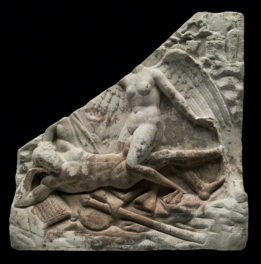
Garden archaeologist Kathryn Gleason
Kathryn Gleason is an expert on Roman gardens and a pioneer in the field of garden archaeology, an exciting and relatively new field. In advance of her lecture on Roman gardens this Saturday at the Getty Villa, she spoke to us about what makes Roman gardens fascinating, how she unlocks the secrets of soil, and why snails, the gardener’s worst enemy, are the garden archaeologist’s best friend.
What do gardens tell us about the past?
Gardens of all kinds can tell us how a culture sought to manage the natural world through cultivation. Gardens offer a condensed view of how cultures handle the larger landscape.
As a result, they also tell us about politics and culture. For example, a person in control of regional water systems and the distribution of the water might display power and resulting wealth in a garden with splendid water features, art, and views out over the well-watered lands. Entire rivers have been diverted for such gardens, from the time of the Assyrian kings to that of Louis IX.
What draws you to Roman gardens?
Because I’m trained as a landscape architect, I’m interested in how designers created the Roman garden. People like to stroll, so a lot of these gardens are laid out in long, linear paths. What did they see as they moved along these promenades?
The Romans were very interested in views, and ultimately this is what the archaeological remains of gardens give us—the three-dimensional experience of the garden that can’t be gained from other kinds of visual and literary evidence.
What is distinctive about Roman gardens?
For the Romans, linear gardens were places where you could view sculpture, fountains, and plants in choreographed groupings, an experience that we’re only beginning to understand. They were also places where conquests and trade items from foreign lands, including plants, could be displayed, almost as they were first seen in triumphal processions.
For example, the sycamore or plane tree (Platanus orientalis) came to the Italian peninsula from Turkey and Asia Minor and was displayed in gardens of the 1st century B.C. as a shade tree. The idea of a tree being useful for nothing but offering a place to sit in the shade seemed a bit decadent to the conservative Romans—such activity was for decadent Persian monarchs and old Greek philosophers!
What physical clues do you find in a 2,000-year-old garden?
We don’t yet have the evidence we need to know, reliably, the specific plants that were growing in a garden—that’s disappointing for many people. But we can learn a great deal about a garden’s layout and meaning from what we can find.
For example, we find holes where the plants were planted, and we can make out cultivated soil as opposed to the beaten-earth of paths. We can trace the water systems, and the remains of fences, trellises, shrines, sculpture bases.
How do you investigate an ancient garden?
It all begins with the soil. First we use ground-penetrating radar (GPR) to get a look under the surface, or LiDAR to scan the surface.
With GPR, we also work with a soil scientist to do soil coring. The scientist can see in the core if we have cultivated soil. Then we’ll dig test trenches to get a closer look. During excavation, we collect environmental remains, such as land snails, so we know which specialists—paleobotanists, entomologists, and malacologists—people who study land molluscs—can help us understand the ecology of the garden.
Snails? What do snails tell us about ancient gardens?
I’m excited about land snails! They tell us which areas were sunny or shady, which were drier or moister. Lands snails can be quite specific to certain plants or locations.
What other technologies are being used in garden archaeology?
There’s so much developing in the field, such as the study of phytoliths, and diatoms, as well as the emerging field of plant DNA. Such new types of evidence add to the methodology we’re developing for this new discipline, shortly to be published as A Sourcebook for Garden Archaeology (edited by Amina Aicha Malek).
You’ve just discovered a garden in ancient Stabia, near Pompeii. What have you found there?
It’s a monumental garden like the Getty Villa’s, surrounded by colonnades, but much wider. Promenades between rows of trees and wide, densely planted beds were laid out in a linear arrangement across the terrace. People strolled up and down looking at the luxuriant plantings and the spectacular view Mt Vesuvius.
The garden at Stabia is striking because it had almost no art. There are the remains of a pool that had slipped off the edge of a cliff during a landslide—so no water feature as lovely as the one here at the Villa, although nearly a third of the garden remains buried under the volcanic ash.

The Outer Peristyle at the Getty Villa. © 2005 Richard Ross with the courtesy of the J. Paul Getty Trust
You’ve also discovered flower pots in the villa of the ancient poet Horace. What do these pots tell us?
We’ve found flower pots in many of the Roman gardens we’ve excavated. The pots mark the location of the plants in the garden, which helps us understand the design.
Gardens take a lot of work. Who actually created and maintained the Roman garden?
We know of the topiarius; “landscape gardener” would be the closest parallel. He would lay out the design, create the arrangements of the garden. There were also different gardeners and workers who took care of the garden.
You’re currently finishing Gardens of the Roman Empire, a book project begun by great garden archaeologist Wilhemina Jashemski.
It was her final project, the culmination of her life’s effort to study the range of gardens found in the daily life of all Romans. The book will lay the groundwork for the field of garden archaeology. It has two parts: interpretive essays and a catalogue of Roman gardens, with between 1,500 and 2,000 examples. This will be the first time all these sites will be brought together, and we hope it will lay the groundwork for new interpretations.
You’ve been working in garden archaeology for 30 years. What have been your most exciting moments?
When all the fragmentary evidence comes together—and suddenly we realize we can reconstruct something about the life of the garden, as opposed to buried terraces of earth.
The work is really just beginning, and with the evidence building almost exponentially, we’ll find so much more in the coming years.




Comments on this post are now closed.
Trackbacks/Pingbacks